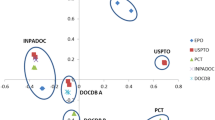Abstract
Since the pioneering studies of Carpenter & Narin (1983), and Narin & Noma (1985), non-patent references (NPRs) in patent documents have been widely used as an indicator of science-technology links. Meyer (2000) reviewed previous work in the patent citation literature and found that citation links between patents and papers are, if not explicitly, at least implicitly viewed as an indication of the contribution of science to technology. Using a sample of 850 patents of New Zealand companies granted by the USPTO between 1976 and 2004, we find evidence of systematic noise in NPR data. We suggest that future research should pay close attention to heterogeneity among countries, and that one should demonstrate more caution in applying and interpreting results based on the NPR methodology.
Similar content being viewed by others
References
Acosta, M., Coronado, D. (2003), Science-technology flows in Spanish regions: An analysis of scientific citations in patents, Research Policy, 32(10): 1783–1803.
Callaert, J., Van Looy, B., Verbeek, A., Debackere, K., Thijs, B. (2006), Traces of prior art: An analysis of non-patent references found in patent documents, Scientometrics, 69(1): 3–20.
Cameron, A. C., Trivendi, P. K. (1998), Regression Analysis for Count Data, Cambridge University Press, Cambridge, UK.
Carpenter, M. P., Narin, F. (1983), Validation study: Patent citations as indicators of science and foreign dependence, World Patent Information, 5: 180–185.
Cockburn, I., Henderson, R. (1998), Absorptive capacity, coauthoring behaviour, and the organization of research in drug discovery, Journal of Industrial Economics, 46(2): 157–182.
Collins, P., Wyatt, S. (1988), Citations in patents to the basic research literature, Research Policy, 17(2): 65–74.
Fleming, L., Sorenson, O. (2004), Science as a map in technological search, Strategic Management Journal, 25(8–9): 909–928.
Gittelman, M., Kogut, B. (2003), Does good science lead to valuable knowledge? Biotechnology firms and the evolutionary logic of citation patterns, Management Science, 49(4): 366–382.
Grupp, H., Schmoch, U. (1992), Perception of scientification as measured by referencing between patents and papers. In: H. Grupp (Ed.), Dynamics of Science-Based Innovation. Springer-Verlag, Berlin, pp. 73–128.
Hall, B., Jaffe, A., Trajtenberg, M. (2000), Market value and patent citations: A first look, NBER Working Paper 7741, Cambridge, MA
Hall, B. H., Jaffe, A. B., Trajtenberg, M. (2001), The NBER patent citations data file: Lessons, insights and methodological tools, NBER Working Paper 8498, Cambridge, MA.
Harhoff, D., Narin, F., Scherer, F. M., Vopel, K. (1999), Citation frequency and the value of patented inventions, Review of Economics and Statistics, 81(3): 511–515.
Hausman, J., Hall, B. H., Griliches, Z. (1984), Econometric models for count data with an application to the patents R&D relationship, Econometrica, 52(4): 909–938.
Henderson, R., Cockburn, I. (1994), Measuring competence? Exploring firm effects in drug discovery, Strategic Management Journal, Winter Special issue, 15: 63–84.
Jaffe, A. (1989), Real effects of academic research, American Economic Review, 79(5): 957–970.
Lanjouw, J. O., Schankerman, M. (2004), Patent quality and research productivity: Measuring innovation with multiple indicators, Economic Journal, 114(495): 441–465.
Meyer, M. (2000), Does science push technology? Patents citing scientific literature. Research Policy, 29(3): 409–434.
Meyer-Krahmer, F., Schmoch, U. (1997), Chemistry, Information Technology, Biotechnology and Production Technology: A Comparison of Linking Mechanisms in Four Fields, Fraunhofer Institute for Systems and Innovation Research, Karlsruhe, Germany.
Narin, F., Hamilton, K. S., Olivastro, D. (1997), The increasing linkage between US technology and public science, Research Policy, 26(3): 317–330.
Narin, F., Noma, E. (1985), Is technology becoming science? Scientometrics, 7(3–6): 369–381.
Narin, F., Olivastro, D. (1998), Linkage between patent and papers: An interim EPO/US comparison, Scientometrics, 41(1–2): 51–59.
Nelson, R. R. (1982), The role of knowledge in R&D efficiency, Quarterly Journal of Economics, 97(3): 453–470.
The New Zealand Business Who’s Who, various editions, New Zealand Financial Press Ltd, Auckland, New Zealand.
Sorenson, O., Fleming, L. (2004), Science and the diffusion of knowledge, Research Policy, 33(10): 1615–1634.
Sorensen, J. B., Stuart, T. E. (2000), Aging, obsolescence and organizational innovation, Administrative Science Quarterly, 45(1): 81–112.
Tijssen, R. J. W., Buter, R. K., Van Leeuwan, T. N. (2000), Technological relevance of science: An assessment of citation linkages between patents and research papers, Scientometrics, 47(2): 389–412.
Trajtenberg, M. (1990), A penny for your quotes: Patent citations and the value of innovations, Rand Journal of Economics, 21(1): 172–187.
Van Dalen, H. P., Henkens, K. (2001), What makes a scientific article influential? Scientometrics, 50(3): 455–482.
Van Looy, B., Debackere, K., Callaert, J., Tijssen, R., Van Leeuwen, T. (2006), Scientific capabilities and technological performance of national innovation systems: An exploration of emerging industrial relevant research domains, Scientometrics, 66(2): 295–310.
Van Looy, B., Zimmermann, E., Veugelers, R., Verbeek, A., Mello, J., Debackere, K. (2003), Do science-technology interactions pay off when developing technology? An exploratory investigation of 10 science-intensive technology domains, Scientometrics, 57(3): 355–367.
Verbeek, A., Debackere, K., Luwel, M., Andres, P., Zimmermann, E., Deleus, F. (2002), Linking science to technology: Using bibliographic reference in patents to build linkage schemes, Scientometrics, 54(3): 339–420.
Zucker, L. G., Darby, M. R. (1996), Star scientists and institutional transformation: Patterns of invention and innovation in the formation of biotechnology industry, Proceedings of the National Academy of Science, 93(23): 12709–12716.
Author information
Authors and Affiliations
Corresponding author
Rights and permissions
About this article
Cite this article
He, ZL., Deng, M. The evidence of systematic noise in non-patent references: A study of New Zealand companies’ patents. Scientometrics 72, 149–166 (2007). https://doi.org/10.1007/s11192-007-1702-3
Received:
Published:
Issue Date:
DOI: https://doi.org/10.1007/s11192-007-1702-3




